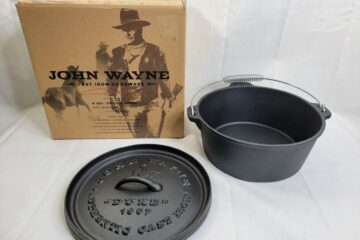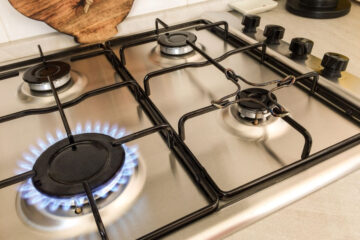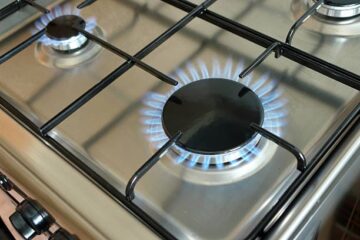Cleaning up burnt milk from a stove can be a daunting task, but it’s a common problem that many people encounter in their kitchens. Burnt milk can leave a stubborn stain on the stove, which can be challenging to remove. There are several ways to get burnt milk off the stove, and it’s essential to choose the right method for your stove type and the severity of the stain.
For glass-ceramic stoves, it’s crucial to avoid using abrasive materials that can scratch the surface. Instead, you can use a non-scratch scouring pad or a plastic razor blade scraper to remove the burnt milk. For standard and metal cooktops, you can use baking soda, a razor blade, or a stove cleaner to get rid of the stain. Vinegar with dish detergent is another effective solution to remove burnt milk from the stove. Before attempting any cleaning method, it’s essential to consult the manufacturer’s instructions to avoid damaging the stove.
Preparation
Before attempting to remove burnt milk from a stove, it is important to prepare the necessary materials and tools. This will make the process smoother and more efficient. The following sub-sections outline what is needed and what steps to take.
Gathering materials
The following materials are needed to remove burnt milk from a stove:
- Baking soda
- Dish detergent
- Water
- Razor blade or scraper (plastic or metal)
- Non-scratch scouring pad
- Melamine foam sponge (e.g. Magic Eraser)
- Vinegar (optional)
- Stove cleaner (optional)
It is important to consult the manufacturer’s instructions for the stove before using any of these materials. Some materials may be unsuitable for certain types of stoves.
Removing excess burnt milk
Before attempting to remove burnt milk from a stove, it is important to remove any excess burnt milk. This can be done using a non-scratch scouring pad or a melamine foam sponge. Wet the pad or sponge and gently rub the burnt area. Be careful not to scratch the stove surface.
If there is still a significant amount of burnt milk on the stove, a razor blade or scraper can be used to remove it. Plastic scrapers are recommended for glass and ceramic stovetops, while metal scrapers are suitable for standard and metal cooktops. Be careful not to scratch the stove surface.
After removing the excess burnt milk, a mixture of dish detergent and water can be applied to the burnt area. This can be sprayed directly onto the stove or applied to a damp towel or sponge. Gently rub the burnt area until the burnt milk is removed.
In some cases, baking soda can be used to remove burnt milk from a stove. Mix baking soda with water to form a paste and apply it to the burnt area. Let it sit for a few minutes before rubbing it with a damp towel or sponge.
If the above methods do not work, a stove cleaner or vinegar can be used. Follow the instructions on the cleaner or mix vinegar with dish detergent and water before applying to the burnt area.
Cleaning the Stove
Cleaning burnt milk off a stove can be a frustrating and difficult task. However, with the right tools and techniques, it can be done quickly and easily. In this section, we will discuss two effective methods for cleaning burnt milk off a stove: using baking soda and using vinegar.
Using Baking Soda
Baking soda is a common household item that can be used to clean many surfaces, including a stove. It is an effective cleaner and can help remove burnt milk stains from a stove.
To use baking soda to clean a stove, follow these steps:
- Mix baking soda with water to create a paste.
- Apply the paste to the burnt milk stain on the stove.
- Let the paste sit on the stain for a few minutes.
- Scrub the stain with a sponge or scrub brush.
- Rinse the stove with water and dry with a clean cloth.
Using Vinegar
Vinegar is another effective cleaner that can be used to remove burnt milk stains from a stove. It is a natural cleaner and can be used on many surfaces, including glass and ceramic stovetops.
To use vinegar to clean a stove, follow these steps:
- Mix equal parts of vinegar and water in a spray bottle.
- Spray the mixture onto the burnt milk stain on the stove.
- Let the mixture sit on the stain for a few minutes.
- Scrub the stain with a sponge or scrub brush.
- Rinse the stove with water and dry with a clean cloth.
It is important to note that vinegar should not be used on marble or granite surfaces, as it can damage the surface.
Deep Cleaning
When it comes to deep cleaning a stove with burnt milk, there are a few options available. Using a commercial cleaner or a razor blade are two popular methods.
Using a Commercial Cleaner
Using a commercial cleaner can be an effective way to remove burnt milk from a stove. These cleaners are specifically designed to tackle tough stains and can be found at most hardware or home supply stores.
To use a commercial cleaner, follow these steps:
- Make sure the stove is cool.
- Apply the cleaner to the burnt area according to the manufacturer’s instructions.
- Let the cleaner sit for the recommended amount of time.
- Wipe the area clean with a damp cloth or sponge.
- Rinse the area thoroughly with water and dry with a clean cloth.
Some popular commercial cleaners include Weiman Cooktop Cleaner and Bar Keepers Friend Cooktop Cleaner.
Using a Razor Blade
Using a razor blade is another option for deep cleaning a stove with burnt milk. This method requires a bit more caution, as using a razor blade improperly can scratch or damage the stove’s surface.
To use a razor blade, follow these steps:
- Make sure the stove is cool.
- Hold the razor blade at a 45-degree angle and gently scrape the burnt area.
- Wipe away any debris with a damp cloth or sponge.
- Rinse the area thoroughly with water and dry with a clean cloth.
It’s important to note that this method should only be used on glass or ceramic stovetops. Using a razor blade on a metal stovetop can cause damage.
Prevention
Preventing burnt milk on the stove is the best way to avoid the hassle of cleaning it up later. There are a few simple steps that can be taken to prevent burnt milk from occurring.
Using a Splatter Screen
One way to prevent burnt milk from sticking to the stove is to use a splatter screen. This screen can be placed over the pot or pan while cooking to prevent any splatters or spills from reaching the stove. Splatter screens are typically made of metal mesh and can be found at most kitchen supply stores.
Cleaning up spills immediately
Another way to prevent burnt milk on the stove is to clean up spills immediately. If milk spills onto the stove, it should be wiped up with a damp cloth or paper towel as soon as possible. This will prevent the milk from drying and sticking to the stove, making it much easier to clean up later.
It is also important to avoid leaving milk unattended on the stove. Milk can boil over quickly and cause a mess on the stove. Keeping a close eye on the milk while it is heating up can prevent any spills or splatters from occurring.
By taking these simple steps, burnt milk on the stove can be prevented, making cleaning up the kitchen much easier and less time-consuming.
Conclusion
Getting burnt milk off a stove can be a frustrating and time-consuming task. However, with the right tools and techniques, it can be accomplished quickly and easily. In this article, we have discussed several methods for removing burnt milk from stovetops, including using baking soda, a razor blade, stove cleaners, vinegar, and dish detergent.
When choosing a method, it’s essential to consider the type of stovetop you have. Glass and ceramic cooktops require gentler cleaning methods to avoid scratching the surface. In contrast, standard and metal cooktops can withstand more abrasive cleaning methods.
It’s also important to follow the manufacturer’s instructions for cleaning your stovetop. Using the wrong cleaning product or technique can damage the surface or void the warranty.
In conclusion, removing burnt milk from a stove is a task that can be accomplished with the right tools and techniques. By following the tips and methods discussed in this article, you can quickly and easily remove burnt milk stains from your stovetop, leaving it looking clean and new.



